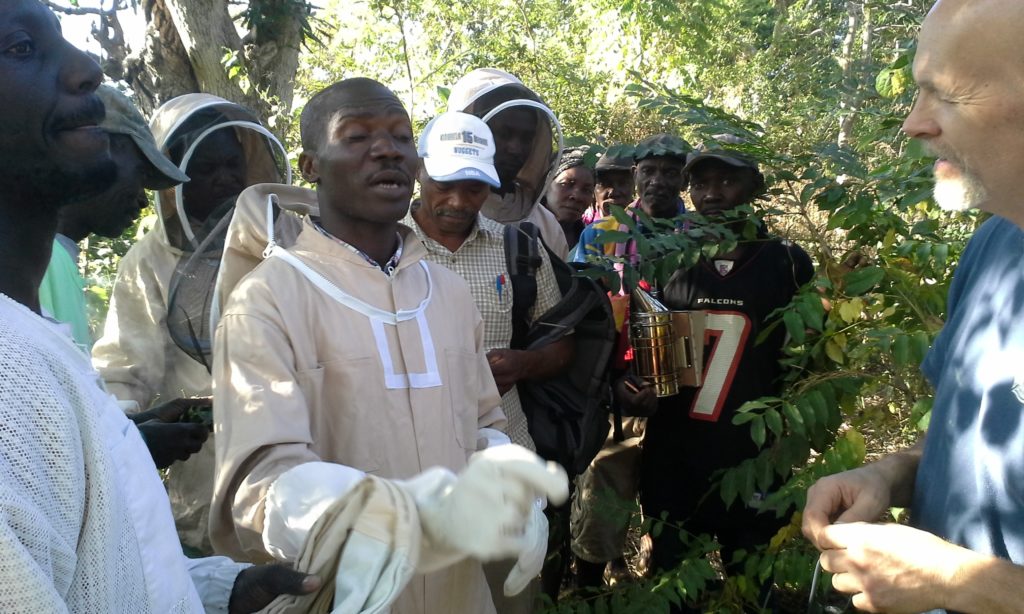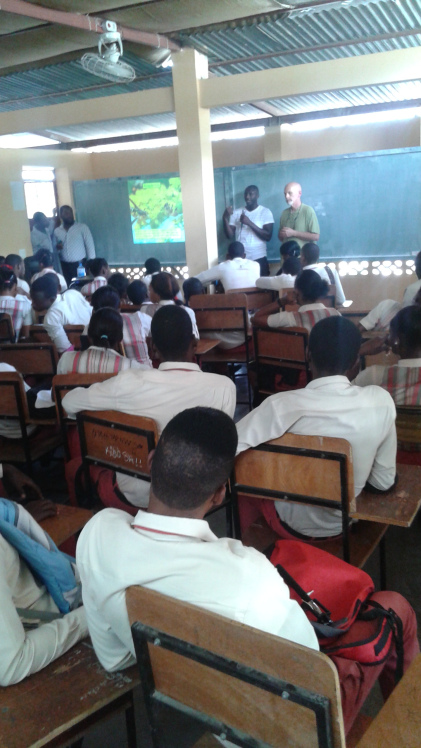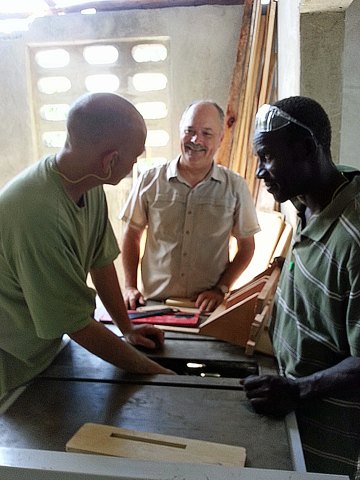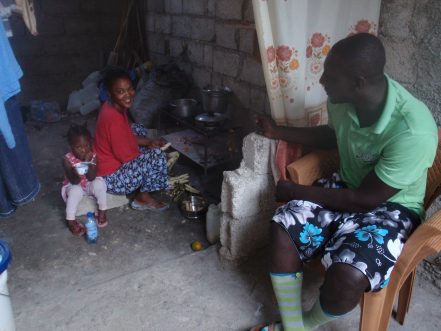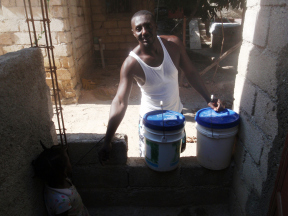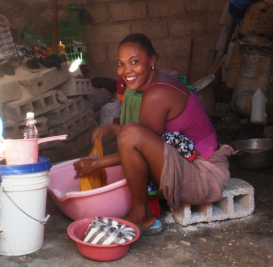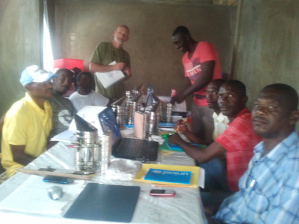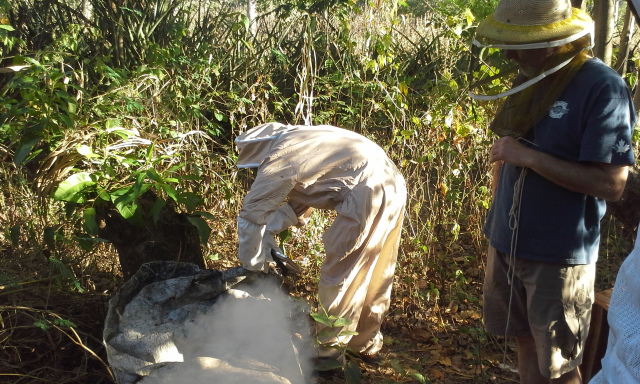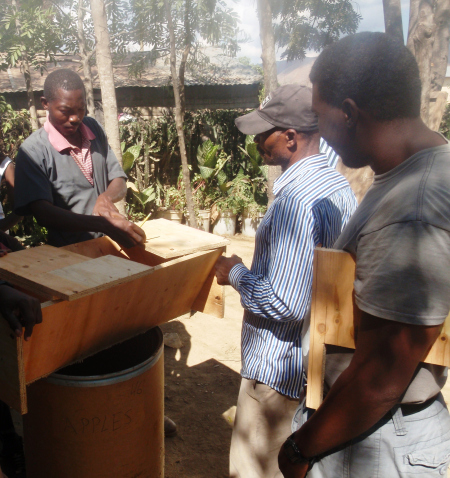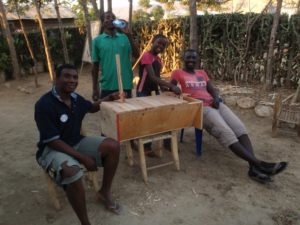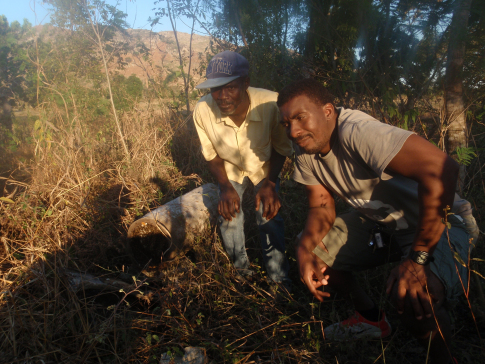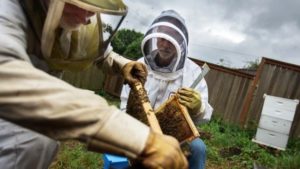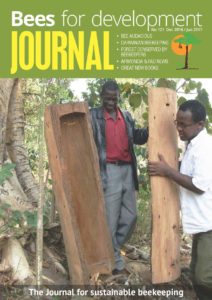Hives For Haiti – David MacDonald & Brian Coombs
Hives For Haiti and Our Beekeeping Adventures (story featured in BeesCene Magazine spring 2016)
By David MacDonald & Brian Coombs
(Originally published here by David MacDonald & Brian Coombs)
They were pretty sure we wouldn’t come back.
In the fall of 2013, Brian Coombs and I were giving an informal beekeeping talk at Ojene Nord’s farm on the outskirts of Cerca Carvajal, Haiti. As we answered questions, angry honey bees began dive bombing, pinging and circling; we were ample distance from his bee yard, we hadn’t opened any hives or even walked close to them. Huh? Curious and a little distracted, we carried on with our talk. Ojene was thrilled when we agreed to inspect his hives and demonstrate splitting of colonies to increase his numbers. He’d hit a plateau in growing his apiary; he was constantly losing swarms and didn’t know how to conduct hive splits or develop new queens.
Smokers lit, we enter the bee yard with grand visions of mango forests, avocados, coffee plantations, and honey bees teeming from all the new apiaries. Hungry children, wonderment in their eyes, taste the sweet labours; and, of course, honey jars fill the shelves of every Port au Prince grocery store.
A puff or two of smoke, a little recap about the splitting procedure and Ojene pops the palm leaf lid. “Wow, look at all the propolis; it looks like tar”, I say. We briefly explain the benefits of bees that heavily propolise their hives. Then, suddenly, we’re under assault – machine gun pinging. Ojene is fully suited in the new protective gear Two Bees Apiary has provided. Brian and I have nothing.
“Hmmm, maybe this wasn’t such a good idea,” says my inside voice. We’ve visited this apiary in the past, and the bees were very gentle, so I hadn’t been concerned that we didn’t have gear. I am now! Did I mention Brian had never been stung and there was a family history of serious allergic reactions? He was supposed to bring an epipen and some Benadryl.
By now there are half a dozen bees under my glasses. No sooner do I say to Brian, “Uh oh, we’d better close this up,” than the first sentry delivers a shot of venom to my left eye lid.
Now we’re in for it! Dozens of bees are stinging me! I look at Brian and he’s standing amidst a frantic cloud of attackers. I turn to Ojene to hand him the smoker and witness a horrible black bee tornado erupting from the box. Wait, it gets worse. As the cloud of alarm pheromone broadens, neighbouring boxes join the melee.
We can’t lose face, so running isn’t an option. Brian walks briskly north to the old dirt trail; I head south – the voice of our friend and translator, Garry St Louis, guides me, “thees way, theees waaay, Daveed, thees way”. You know, it was Garry’s first experience with bees and I can’t believe he ever entered another bee yard with me. He did, he does, he’s now an integral part of beekeeper training with Hives For Haiti.
Angry bees, relentless, everywhere; we skedaddle four or five hundred metres and jump a small creek. Finally, they give up the chase.
One of my most cherished memories: a beautiful ancient Haitian woman, must have been one hundred, approaching me as everyone else was fleeing the scene. Where the path brought us together, she stopped me, produced a smouldering roll of cotton and sung circles around me while fanning the embers. She blew smoke from my feet to the top of my “blan tèt kale” (the children of Haiti squealed, “blan tèt kale” – white bald head).
” What the Hell was that”, I said to Brian. ” Are you okay? Are you having any reaction? That had to be African stock, but there aren’t any Africanized bees in Haiti, are there?” Two key traits of African bees are: they have a much wider defence zone (e.g. pinging & aggression when we were giving our talk), and they’ll chase you for half a kilometre or more once they commence a defensive attack, as we had just so unceremoniously experienced.
Fortunately, Brian’s only reaction to the fifty plus stings was a three week respite from nagging arthritis.
We contacted our friend John Gibeau for his knowledge of Africanized bees in Haiti and the Dominican Republic (we’d previously helped John with one of his Bee World Projectsin Jeremie, Haiti). John confirmed that African stock had been identified in the Dominican Republic and that they had moved across the border into North East Haiti. That’s where we were working.
Trianing in Jeremie with John Gibeau
This changed everything. Brian and I didn’t have any experience working with African stock. We knew you had to give them a wide berth and we knew a few basic behavioural traits, but not how to effectively manage them. We went home to re-tool our program in order to accommodate the eventual influx of this less accommodating Apis Mellifera sub species.
A year went by. We were reading all the publications we could get our hands on and talking to as many beekeepers, who had experience with African stock, as we could find. Our knowledge base was building, and we were pretty close to pulling the trigger on booking our return flight to Haiti when Susan, my partner, became gravely ill. Our trip was indefinitely on hold. This was when doubts set in amongst our Haitian friends, that we were ever coming back. Sadly, the Haitian people have become accustomed to people making well-intentioned promises to help and then not returning.
As I said in the opening, no doubt they figured we were staying home because of the Wild West stinging melee of 2013.
But we did go back. I’m happy to say that as 2015 wound up, Susan’s health greatly improved. The trip was booked, and on December 28 I boarded Flight AC1134 to Montreal. Two bad things: Brian couldn’t come due to illness in his family, and a Quebec snow storm meant that I had to spend three days in Montreal waiting for the next available flight to Miami, then Haiti. The silver lining was that I got to see Montreal. Wow!
January first, I finally landed in Haiti. There were Garry and his cousin Tommy to greet me. I was thrilled and relieved to see my dear friends. It’s always a little dicey at the Port au Prince Airport.
They had a number of events planned for the first few days of the trip: lecturing at the Petionville High School, visiting Tommy’s home in Fort Jacques, working his cousin’s captured swarms, visiting Garry’s family in the further region of Fort Jacques to assess our potential permaculture/beekeeping projects, and observing feral bees at his Uncle’s homestead. Like so many feral colonies we observed during the trip, these bees have survived unmanaged for more than five years.
Left to right: Saliyah, Rosemene, Garry
A big part of those first few days was Garry’s family sharing their home and culture with me. How fortunate and honoured I was to experience their deep warmth and generosity. Haiti is the poorest country in the Western hemisphere. Yet, they give all with abandon.
I stayed in Garry’s little home in Girardo on the outskirts of Petionville. His wife Rosemene cooks the most wonderful Haitian dishes, like goat stew, pumpkin soup, and spicy fish, all prepared in a little steel pot over a charcoal rack on the dirt floor. Family would come and visit throughout the day. At times we were confined to the home because it wasn’t safe to go out due to political demonstrations. When things were quieter, I’d walk the shanty’s gravel trails with Garry’s brother Watly and meet the gregarious residents of Petionville.
Garry and Rosemene’s home. A welcoming home for weary travelers.
Garry’s house is a typical Haitian home, a concrete structure approximately 20′ x 18′ with high walls for security. One room, covered with a concrete roof, is split into two parts; one for sleeping and the other for a bathroom. The remainder of the house is a room with a dirt floor and a torn tarp cover. This is where Rosemene does all of her cooking, laundry, etc.
There is no running water. During the dry season, Garry has to walk up to one hour to get water from a stream. At night we slept in the 8′ x 10′ bedroom. Depending on which family members were there, we might be seven cozied up for the night.
Garry collecting water
January fifth, Johnny picked us up at 10 AM Haiti time for the long journey to Cerca Carvajal. We refer to three time zones in Haiti: US time (i.e. on time), Haiti time (i.e. something within an hour or two of the proposed time), and Brice time (i.e. sometime within a day of the proposed time).
As you’ve deduced, the actual time Johnny picked us up was 11:05 AM. He said, “It’ll be about three hours to get to Cerca”. I looked at Garry, “So we’re looking at about five hours”. He nodded his agreement (Garry operates strictly on US time). We arrived without incident at 4:55 PM.
Rosemene
I was looking forward to a little settle-in time with our billet family, but Pastor Brice (community leader, coordinator of the Cerca Carvajal beekeeper training, and founder of the “Brice time zone”) was too excited for any delays. He’d received confirmation of our departure from Port Au Prince so the class would be ready to go at 9:00 AM, US time, January 6; on this, there could be no debate.
January sixth, we were greeted by eight eager faces. It was immediately evident that Garry’s fall of 2015 training in Canada had been a most worthwhile investment. The translation was so much more effective than it had been in the past. On prior trips, Brian and I had had to spend much of our time teaching our translators the language of beekeeping (something they would never pick up in English lessons) and explaining the concepts behind each management technique before they were able to convey the information to the class. You can imagine how cumbersome this was in the field with thousands of bees zipping about. Now Garry is proficient in beekeeping, as well as English and Creole beekeeping terminology. His confidence shone through as he delivered the materials with great proficiency. I felt encouraged and optimistic about our prospects for success.
During introductions, the class expressed tremendous appreciation for the opportunity to learn the skills of apiary management. Something that one of the students, Simon, shared gave me the sense that we were closing in on our long term goal, “What you are giving is a great gift. I have wanted it so much since I heard about the training and was accepted to attend. Not only are you giving this to me, you are giving it to my community, because when I am finished I will teach them”. I recall wishing Brian was there to hear Simon’s words. Brian has been a committed partner in this venture and I knew he’d have found great reward in what Simon said.
We spent ten full days in the classroom with breaks to practice in the field. Sometimes the classroom was so hot I thought I’d melt. I was probably consuming a gallon of water a day. It was a big relief to get out to the avocado forest to work bees.
Simon inspecting tarp lid hive. This colony demonstrated behaviour we’d normally associate with Africanized bees.
We hired Junell, a local carpenter, to build top bar hives (TBH) for each participant. This way we’d be contributing to the local economy and respecting the technological and human resources that are already established in Haiti (e.g. hand tools, local trades, local food, etc.). Johnny suggested the carpenter come to our school location and have the students build the boxes with him. What a great idea. We had a fabulous TBH design that Bo Sterk from Florida had developed and shared with us. You can make four 60 cm TBHs from one sheet of plywood.
Left to right: Junell (Carpenter), Patrick (Student), Johnny (Translator/Trainer)
This is the perfect size for African bees but a little short for European. We modified the design to get exactly five 89 cm TBHs from two sheets of plywood. We spent the day constructing hives and I’m pleased to tell you that the students are now constructing them on their own. Junell was really something to watch with that hand saw. He ripped through a sheet of plywood in no time. He even cut each top bar by hand, and notched them middle and ends. That’s 27 top bars per box! We worked a number of colonies over the two weeks in Cerca Carvajal; most of them were gentle. Only two colonies showed the signs of aggression we’d normally associate with African stock. Fortunately, we’d taken a cautious approach and treated each colony as though it was African. This prevented the miserable ones from “going critical”. I got that most apt term from Conrad Berube of Bees For Babar.
First TBH completed
A little digression – what Brian and I learned about keeping African stock calm, you can implement in your local apiary to reduce defensive behaviour. Most beekeepers have experienced it on a hot summer day during a dearth. The bees can be most unpleasant.
Tips for preventing your bees from going nuts:
- “Prevent the colony from going critical.” (Conrad Berube) If the colony is showing signs of aggression, close up the box and come back when conditions are more favourable.
- Visit the apiary on a day when it’s not too hot. Bees will react aggressively if it’s very hot, rainy, cold, or there is lightning.
- If necessary, move the hive to another location and leave an empty box at the original site (the foragers and guard bees will return to the original site while you are inspecting the colony).
- Do not squish bees. If you can, work without gloves. This will result in fewer bee squishing incidents (i.e. less alarm pheromone).
- Minimize inspections during a dearth. If inspection must be done, the best time is 30 minutes before sundown, or before noon (i.e. when it’s cool).
- Do not wear dark colours.
- Use cool smoke, sparingly.
- Do not wear perfumes . Wash prior to visiting the apiary. Bees do not like body odour.
- Try not to breathe on the bees. They react negatively to C02.
- Consider avoiding bananas. The chemical in the alarm pheromone (isoamyl acetate; also known as isopentyl acetate) is also a component of banana flavour. Depending on who’s opinion you read, it can be benign or cause aggression. We err on the side of caution and avoid bananas prior to visiting the apiary.
- Use a soft cover to minimize light entering the hive. We use burlap.
- Use natural smoker fuels: e.g. burlap, wood chips, grass, coconut husks, pine needles, pine cones. Some resources claim that dung smoke can provoke aggression, others say it’s a good fuel. We’re avoiding using it.
- Prevent ants from entering the hive. They put the colony on the defensive.
- Start working at the furthest hive from your vehicle and finish at the closest. Try to avoid wandering back and forth through the apiary.
- Do not re-open hives that have been inspected.
- Space the hives in the apiary so that alarm pheromone is not detected by the neighbouring colony. Three metres should do the trick.
- Wear clean gloves and coveralls. Alarm pheromone lingers in the fibres.
- Avoid leaving wax and honey around the apiary; it promotes robbing, which promotes defensive behaviour.
Back to Haiti – the most exciting field day was in a mixed mango and avocado forest. One of the students, Pierre, took us on a fifteen “Haitian minute” walk, one hour each way, to see multiple feral colonies living in avocado tree trunks. Pierre has been monitoring them for many years. One of them had survived for ten years and the youngest was five years. Previously, the locals had simply smoked the bees out and robbed the honey. Now they are allowing them to flourish and our students set bait hives throughout the forest canopy. One of the students caught a swarm last week (early Feb.).
On our last field day we visited a “bee haver” who has one hundred log hives and thirty six children. Ghee Ghee is a magnanimous character like no other. Long, lean, animated, he refers to himself as the best beekeeper in Haiti. He must be 55, and he’s been keeping bees on the property since he was a kid.
Left – log hive …Middle – Ghee Ghee … Right – Johhny
Nobody knew anything about varroa mites, but I figured Ghee Ghee must have experienced their arrival. I asked him if he’d ever known a collapse of his colonies. He said that in 1995 he lost all but three hives. He has a spiritual theory for why they died, but I suspect it was varroa. Since that time his stocks have been replenished through the capture of swarms. He does not do any management, yet he apparently doesn’t suffer losses, presently, with the exception of swarms.
We bought a couple of log hives from Ghee Ghee to demonstrate a cut out and transfer to Top Bar and Langstroth hives. When we arrived, Ghee Ghee insisted we eat honey. He led me to the back of his hut where three active log hives sat in the shade of a gnarled old mango tree (note: never use mango bark or leaves in your smoker – the smoke is toxic to bees). Ghee Ghee lit a roll of blue jean material and waved it around the busiest log. He reached in and sliced a six inch honey comb and handed it, sticky and dripping, to me. I thought we were done and turned to walk back to our meeting place. “Rete Daveed”, he said, and cut two more jumbo combs that must have weighed three pounds each. The pollen tasted just like the sour candy we used to buy at Mr. Huxom’s grocery store when we were kids. The honey was dark, complex, and rich. I ate so much I feared I’d burst, or at least go into a hyperglycemic coma.
In 2013 Brian and I defined our benchmark for success: If the people we’ve taught can independently utilize the knowledge we’ve shared, we’d be achieving our goal. I spoke to Johnny on the phone yesterday (February. 9). He wanted to report that he has bought a saw and is building TBHs. He was headed to Cerca Carvajal on February 11 to do a cut out transfer with the rest of the class. Simon caught a swarm in his TBH and has just finished teaching six new beekeepers all that he learned in our class. He has another group starting next week. Garry is helping his cousin Shaneh manage his swarm captures, and Tommy is teaching his high school class honey bee biology and the benefits of pollinators. I was pretty happy.
Cerca Carvajal Beekeepers Association
We’ve applied for visitors’ Visas for Johnny and Simon to come to Canada for this May, June, and July. They will receive intensive beekeeper and instructor training. They will return to Haiti and share their new skills in a manner that is the most relevant and effective within the Haitian culture. Brian and I will continue to visit Haiti and support the program. However, our goal remains that we will eventually become redundant.
Thanks so much to: Paul Van Westendorp, Conrad Berube, John Gibeau, Les Eccles and Bo Sterk, for sharing their time and resources regarding the management of African bees. Without their help, we
would have had to stay home. Also, many thanks to our generous financial contributors (including Brian who kept us afloat when we ran out of funds in Hinche), and to Wendi Gilson, Frank Stuber, Helmer Gysler, Denby Greenslade, Bonnie Walker, Amandeep Singh, and Stephanie Imhoff – your help has been more appreciated than you’ll ever know.
David Macdonald
David worked in the Fire Service for 25 years and retired to Salt Spring Island in May of 2014 . Retirement was short lived; in February of 2015 he was hired by the BC Ministry of Agriculture as the Apiary Inspector South Vancouver Island and Gulf Islands.
David has also filled the role of District Beekeeper for the District of North Vancouver, and hosted three of his own thriving apiaries around the lower Mainland.
He is a certified Bee Master through the joint UBC/BC Ministry of Agriculture’s Bee Masters program. He is thrilled to be sharing all of his beekeeping knowledge and experience with the Haitian people.
Since 1989, David has contributed to the Fire Services’ local and international volunteer projects.
In early 2013 he responded, with fellow Fire Fighter Brian Coombs (Richmond Fire) and Gerald Brinson (Toronto Fire), to distribute food to starving people in Haiti. They returned to Haiti later in 2013 to assist Bee World Project in the Grand-Anse Province.
Now, this is his focus. Respectfully sharing knowledge and resources with the people of Haiti.
Brian Coombs
Brian Coombs moved west in 1979 and worked in construction before becoming a firefighter. During his 30 year career he has travelled with other firefighters to Sri Lanka, Thailand, El Salvador and Haiti to participate in humanitarian projects.
He plans to continue his humanitarian work after retirement. When David presented him with the idea of fostering beekeeping in Haiti, Brian quickly jumped on board. He recognized the tremendous potential to help build independence and sustainability with such a simple plan.
Brian is particularly interested in development and aid projects that promote long-term economic independence, a goal which Hives for Haiti strives for. Through his travel experiences, and work in Haiti, Brian has fallen for this beautiful country and its people.
Brian’s approach to his charity work is “I have more than I need, why wouldn’t I help?”
Outside of his humanitarian endeavours, Brian’s other interests include riding, building and racing motorcycles, building stereo speakers, paddling, sailing and recently, photography.
Brian is the proud steward of two happy bee colonies in Squamish and two more in North Vancouver BC.
Note: bios can be found at the bottom of this page Hives For Haiti and Our Beekeeping Adventures (story featured in BeesCene Magazine spring 2016) They were pretty sure we wouldn’t com…
Source: About Us | Hives For Haiti

